
Glaucocharis chrysochyta is a species of moth in the family Crambidae. This species was first described by Edward Meyrick in 1882. It is endemic to New Zealand and is found throughout the country. It inhabits native forest. Larvae appear to feed on moss and likely pupate there. Adult moths are on the wing from November to March. They fly at night and are attracted to light.

Chersadaula ochrogastra is a species of moth in the family Oecophoridae. This species is endemic to New Zealand. It is classified as "Data Deficient" by the Department of Conservation.
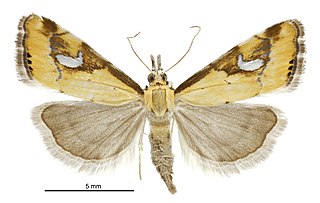
Glaucocharis lepidella is a species of moth in the family Crambidae. It was described by Francis Walker in 1866. It is endemic to New Zealand and is found in both the North and South Island. The species inhabits lowland to subalpine native forest. Larvae may feed on mosses. Adults are on the wing from November to February and are attracted to light.
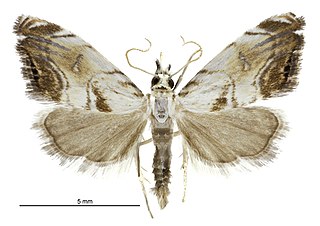
Glaucocharis harmonica is a moth in the family Crambidae. This species was described by Edward Meyrick in 1888. It is endemic to New Zealand and is found in the North and South Islands. It inhabits lowland to subalpine native forest. It has been hypothesised that there are two broods per year. The larval hosts are unknown. Adults are on the wing from October until January.
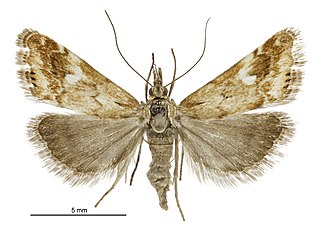
Glaucocharis helioctypa is a moth in the family Crambidae. It was first described by Edward Meyrick in 1882. It is endemic to New Zealand and is only found in the South Island. It can be found throughout the South Island and inhabits native forest in lowland to subalpine altitudes. It has an affinity for damp grassy open situations near native forest or scrub. Larvae of Glaucocharis species feed on mosses and liverworts. Adults are on the wing from November until February. It is dayflying and has been observed flying low over cushion bogs and moss fields. Adults have also been observed flying actively in the hottest sunshine.
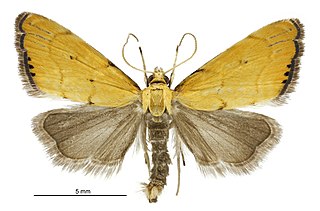
Glaucocharis holanthes is a moth of the family Crambidae. It was first described by Edward Meyrick in 1885. It is endemic to New Zealand and is found in the North and South Islands. This species inhabits native forest or scrub and frequents rock-faces where moss grows. It is apparently attached to places having an exceptionally heavy rainfall. Larvae of Glaucocharis species feed on mosses and liverworts. Adults are on the wing from November to February. It flies very rapidly in hot sunshine and is an elusive insect to catch.

Glaucocharis leucoxantha is a moth in the family Crambidae. It was first described by Edward Meyrick in 1882. It is endemic to New Zealand and can be found in the North, South and Stewart Islands. This species inhabits native forest. Hudson states this species can be met with in South Island native beech forests at elevations of from 1,500 to 2,500 feet above the sea-level. Larvae of Glaucocharis species feed on mosses and liverworts. Adults are on the wing from November until February. This species is very variable in colouration and can be confused with G. lepidella. However it is smaller in size and the crescent shaped spot on its forewings is white or yellow rather than the silver of G. lepidella.

Glaucocharis metallifera is a moth of the family Crambidae. It was first described by Arthur Gardiner Butler in 1877. It is endemic to New Zealand and is found in the southern half of the North Island and the northern half of the South Island. It inhabits native forest at lowland and subalpine altitudes and frequents banks of streams flowing through dense forest clad valleys. The larval host is moss and the larvae are very active and live in galleries in wet moss, on logs or stones in the forest. Adults are on the wing from October to February. It has been hypothesised that this species has two broods per year. Adults have been collected via netting at dusk.
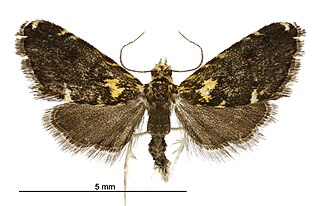
Glaucocharis microdora is a moth of the family Crambidae. It was first described by Edward Meyrick in 1905. It is endemic to New Zealand and is found in the southern parts of the North Island and the north and central parts of the South Island. It inhabits native forest at lowland to subalpine altitudes. The larvae of this species feeds on moss and adults are on the wing from November until February. It is similar in appearance to G. pyrsophanes but can be distinguished as G. microdora is of a smaller size and has bright yellow markings. It also lacks the broad white bars on forewings of G. pyrophanes.

Glaucocharis parorma is a moth of the family Crambidae. It was first described by Edward Meyrick in 1924. It is endemic to New Zealand and is found in the North Island. This species inhabits native forest from lowland to subalpine altitudes. Larvae of Glaucocharis species feed on mosses and liverworts. Adults are on the wing from October to February. This species is very similar in appearance to G. elaina but can be distinguished as a result of the black terminal dots on its forewings.
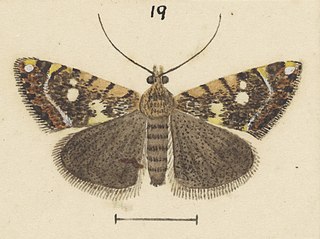
Glaucocharis planetopa is a moth of the family Crambidae. It was first described by Edward Meyrick in 1923. It is endemic to New Zealand and has only be observed on the South Island. G. planetopa inhabits native forest. Larvae of Glaucocharis species feed on mosses and liverworts. Adults are on the wing in January and February. As at 1971 the female of this species had yet to be collected.
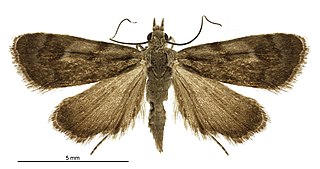
Glaucocharis stella is a species of moth in the family Crambidae. This species was first described by Edward Meyrick in 1938. It is endemic to New Zealand and has been observed in the North Island. Meyrick hypothesised that larvae of G. stella feed on moss. Adults are on the wing in October and November. The colouration of the forewings ensure that when resting with closed wings on rocks adults are highly camouflaged.

Glaucocharis selenaea is a moth in the family Crambidae. It was first described by Edward Meyrick in 1885. It is endemic to New Zealand and is found throughout the country from Manawatāwhi / Three Kings Islands to Southland including the Little Barrier and Great Barrier Islands. It inhabits native forest from lowland to subalpine altitudes. Larvae of Glaucocharis species feed on mosses and liverworts. Adults are on the wing from October until January and are attracted to light. It can be distinguished from the similar appearing G. metallifera as G. selenaea is smaller in size, the diagonal shaped band, the small round white discal spot and the black-marked veins in the near the end of the forewings.

Pyrgotis eudorana is a species of moth of the family Tortricidae. It is endemic in New Zealand and has been observed in both the North and South Islands. However it is regarded as a rare insect. This species inhabits native forest. Larvae exclusively feed on Muehlenbeckia australis and adults are on the wing from November to April. Adults are attracted to light.

Tingena compsogramma is a species of moth in the family Oecophoridae. It is endemic to New Zealand and has been observed in the North and South Islands. This species inhabits native forest and adults are on the wing from December until March.

Tingena eumenopa is a species of moth in the family Oecophoridae. It is endemic to New Zealand and found in the North and South Islands. The adults have been found amongst tree ferns and are on the wing in December.

Tingena horaea is a species of moth in the family Oecophoridae. It is endemic to New Zealand and have been observed in both the North and South Islands. The adults are on the wing in January.

Tingena macarella is a species of moth in the family Oecophoridae. It is endemic to New Zealand and is found on both the North and South Islands. Adults of this species are on the wing from November until February. This species is attracted to light and the larvae are litter feeders.

Tingena pronephela is a species of moth in the family Oecophoridae. It is endemic to New Zealand and is found in the southern parts of the South Island. The species inhabits the outskirts of scrub and native forest. The adults of this species are on the wing from October to February.

Trachypepla lichenodes is a moth of the family Oecophoridae first described by Edward Meyrick in 1883. It is endemic to New Zealand and has been found in both the North and South Islands. It inhabits native forest and adults of this species are on the wing from November to January. The adult moths are similarly coloured to native lichen species however this colouration is variable in the extent and depth on the forewings.






















